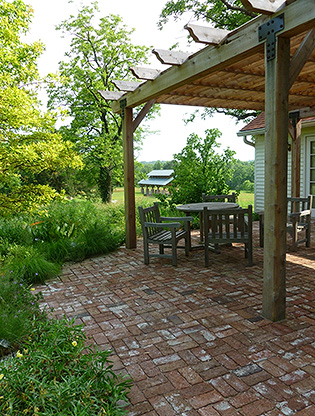 Many new permeable versions of traditional impervious paving products are available that allow water to soak in rather than run off, thereby reducing the quantity of rainwater runoff. In the process, the porous material filters runoff as well as allowing it to infiltrate the soil beneath. In some cases, this type of pavement can be used at the entry to a rain garden or bioswale. Sidewalks, driveways, paths and patios should be designed and constructed with permeability in mind. Existing pavement can be replaced with a permeable alternative. The most common types of permeable pavement include pervious/permeable concrete, porous asphalt and open-grid pavers.
Many new permeable versions of traditional impervious paving products are available that allow water to soak in rather than run off, thereby reducing the quantity of rainwater runoff. In the process, the porous material filters runoff as well as allowing it to infiltrate the soil beneath. In some cases, this type of pavement can be used at the entry to a rain garden or bioswale. Sidewalks, driveways, paths and patios should be designed and constructed with permeability in mind. Existing pavement can be replaced with a permeable alternative. The most common types of permeable pavement include pervious/permeable concrete, porous asphalt and open-grid pavers.
 Permeable pavement typically cost more per square foot than the impervious counterparts. However, the overall environmental benefits (water quality, reduction in flooding and erosion) can benefit everyone and the need for more expensive rainwater infrastructure can be avoided. This type of pavement consists of a permeable surface (i.e. concrete, asphalt, pavers) and a sub-base (gravel/stone) and is a sensible option for high-traffic areas. Driveways, parking areas, pathways and patios are examples of areas that should be considered for a use of a permeable pavement option. Permeable pavement, especially open-grid pavers, is also useful when used to replace impervious pavement around trees to allow water and air to reach the tree roots.
Permeable pavement typically cost more per square foot than the impervious counterparts. However, the overall environmental benefits (water quality, reduction in flooding and erosion) can benefit everyone and the need for more expensive rainwater infrastructure can be avoided. This type of pavement consists of a permeable surface (i.e. concrete, asphalt, pavers) and a sub-base (gravel/stone) and is a sensible option for high-traffic areas. Driveways, parking areas, pathways and patios are examples of areas that should be considered for a use of a permeable pavement option. Permeable pavement, especially open-grid pavers, is also useful when used to replace impervious pavement around trees to allow water and air to reach the tree roots.
The type of soil that exists at the site will determine the depth of the sub-base gravel/stone needed to accommodate the rainwater runoff. This can be ascertained by conducting a percolation test or similar infiltration test. Soils with a slow percolation rate will require a deeper base.
Open-grid pavers have open grids that make it possible to grow low-growing plants within the permeable paving system. Plants such as turf grass, buffalo grass or short sedges are possibilities in this case.
Read about the City of St. Louis Permeable Pavement Alley Pilot Study.
See Permeable Pavement Resources for more information.
Click on a landscaping option from the graphic below to learn more about that topic: